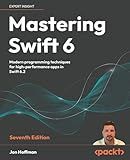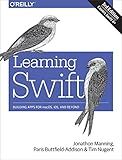Best Swift Programming Guides to Buy in December 2025

iOS 26 Programming for Beginners: A hands-on guide to kickstarting your iOS app development journey with Swift 6, UIKit, and Xcode 26



Mastering Swift 6: Modern programming techniques for high-performance apps in Swift 6.2



Learning Swift: Building Apps for macOS, iOS, and Beyond



Modern Swift Programming: From Fundamentals to Building Your First Apple Apps



SwiftUI for Masterminds 5th Edition: How to take advantage of Swift and SwiftUI to create insanely great apps for iPhones, iPads, and Macs



SwiftUI Cookbook: A guide for building beautiful and interactive SwiftUI apps



iOS 18 Programming for Beginners: Learn iOS development with Swift 6, Xcode 16, and iOS 18 - your path to App Store success



Swift Programming: A Detailed Guide to Learning Essential Concepts and Mastering Advanced Techniques



Swift Programming: The Big Nerd Ranch Guide



iOS 26 App Development Essentials - SwiftUI Edition: Developing iOS Apps Using SwiftUI, Swift and Xcode 26


To make a request body for a PUT request in Swift, you need to create a data object that contains the JSON data you want to send in the body of the request. You can use the JSONSerialization class to convert a Swift dictionary into JSON data that can be sent in the request body.
First, create a dictionary with the data you want to send in the request body. For example:
let userData = ["name": "John Doe", "age": 30]
Then, convert the dictionary into JSON data:
do { let jsonData = try JSONSerialization.data(withJSONObject: userData, options: [])
// Use jsonData in the request body
} catch { print("Error converting data to JSON: \(error)") }
Next, create a URLRequest object and set the HTTP method to "PUT". Add the JSON data to the request body and set the appropriate headers, such as "Content-Type":
var request = URLRequest(url: URL(string: "https://example.com/api/user")!) request.httpMethod = "PUT" request.httpBody = jsonData request.setValue("application/json", forHTTPHeaderField: "Content-Type")
Now, you can use URLSession to send the PUT request with the request body:
let task = URLSession.shared.dataTask(with: request) { data, response, error in // Handle response from server } task.resume()
This is how you can create a request body for a PUT request in Swift before sending it to a server.
How can I encode data in the request body for a PUT request in Swift?
In Swift, you can encode data in the request body for a PUT request using the HTTPBody property of the URLRequest object. Here's an example of how you can encode data in the request body for a PUT request in Swift:
// Create a dictionary with the data to be encoded let data = ["key1": "value1", "key2": "value2"]
// Convert the data dictionary into JSON data let jsonData = try? JSONSerialization.data(withJSONObject: data)
// Create a URL object for the API endpoint let url = URL(string: "https://example.com/api/endpoint")!
// Create a URLRequest object with the PUT method var request = URLRequest(url: url) request.httpMethod = "PUT"
// Set the Content-Type header to application/json request.setValue("application/json", forHTTPHeaderField: "Content-Type")
// Set the HTTPBody of the request to the JSON data request.httpBody = jsonData
// Create a URLSessionDataTask to perform the PUT request let task = URLSession.shared.dataTask(with: request) { data, response, error in // Handle the response data or error here }
// Resume the data task task.resume()
In this example, we first create a dictionary data with the data to be encoded. We then convert this dictionary into JSON data using JSONSerialization.data(withJSONObject:). Next, we create a URLRequest object with the PUT method, set the Content-Type header to application/json, and set the HTTPBody property of the request to the JSON data. Finally, we create a URLSessionDataTask to perform the PUT request and handle the response data or error in the completion closure.
How do I securely transmit sensitive data in the request body for a PUT request in Swift?
To securely transmit sensitive data in the request body for a PUT request in Swift, you can use HTTPS protocol with TLS encryption to encrypt the data in transit. Additionally, you can implement proper authentication and authorization mechanisms to ensure that only authorized users can access and transmit the sensitive data.
Here is an example of how you can securely transmit sensitive data in the request body for a PUT request in Swift:
import Foundation
// Define the URL for the PUT request let url = URL(string: "https://api.example.com/resource")!
// Define the data to be transmitted let sensitiveData = "Your sensitive data here" let jsonData = try? JSONSerialization.data(withJSONObject: ["sensitive_data": sensitiveData], options: [])
// Create the PUT request var request = URLRequest(url: url) request.httpMethod = "PUT" request.httpBody = jsonData
// Add authentication header let username = "yourUsername" let password = "yourPassword" let loginData = "\(username):\(password)".data(using: .utf8) let base64LoginString = loginData?.base64EncodedString() request.setValue("Basic \(base64LoginString)", forHTTPHeaderField: "Authorization")
// Set content type request.setValue("application/json", forHTTPHeaderField: "Content-Type")
// Create URLSession and make the PUT request let session = URLSession.shared let task = session.dataTask(with: request) { data, response, error in // Handle response or error }
task.resume()
In this example, we are creating a PUT request with sensitive data in the request body using JSON serialization. We also add Basic Authentication header with the username and password. This ensures that the request is secure and the sensitive data is transmitted safely. Remember to replace "https://api.example.com/resource", "yourUsername", and "yourPassword" with your actual endpoint and authentication credentials.
What role does the request body play in updating resources in a PUT request in Swift?
The request body in a PUT request contains the data that needs to be updated for the specified resource. In Swift, when making a PUT request to update a resource, the request body typically contains the updated values that will replace the existing data of the resource. This data can be in various formats, such as JSON or XML, depending on the API endpoint's requirements.
To update a resource using a PUT request in Swift, the request body is essential as it carries the new information that will be applied to the resource. By sending the updated data in the request body, the server can process the information and make the necessary changes to the resource accordingly.
Overall, the request body in a PUT request plays a crucial role in updating resources by providing the new data that needs to be applied to the specified resource.
What is the role of the request body encoding type in a PUT request in Swift?
The request body encoding type in a PUT request in Swift is used to specify how the data should be encoded before sending it to the server. This is important because the server expects the data to be in a particular format, and using the correct encoding type ensures that the data is correctly interpreted by the server.
In Swift, the most common encoding types used in a PUT request are JSON, URL-encoding, and raw data. JSON encoding is commonly used for sending complex data structures, while URL-encoding is often used for sending form data. Raw data encoding allows you to send arbitrary binary data.
By setting the appropriate encoding type in a PUT request, you ensure that the data is correctly formatted and that the server can understand and process it correctly. This helps to prevent data loss or corruption during the transfer process.
How can I include parameters in the request body for a PUT request in Swift?
In Swift, you can include parameters in the request body for a PUT request by converting them to a Data object and setting it as the httpBody of the URLRequest. Here is an example of how you can do this:
// Create the URL for the PUT request let url = URL(string: "http://example.com/api/resource")!
// Create the parameters you want to include in the request body let parameters = ["key1": "value1", "key2": "value2"]
// Convert the parameters to a Data object let jsonData = try? JSONSerialization.data(withJSONObject: parameters)
// Create a URLRequest with the URL and set the httpMethod to PUT var request = URLRequest(url: url) request.httpMethod = "PUT"
// Set the httpBody of the URLRequest to the JSON data request.httpBody = jsonData
// Create a URLSessionDataTask with the URLRequest let task = URLSession.shared.dataTask(with: request) { data, response, error in // Handle the response }
// Resume the URLSessionDataTask to make the request task.resume()
In this example, we are creating a PUT request to "http://example.com/api/resource" and including parameters "key1": "value1" and "key2": "value2" in the request body as a JSON object. You can adjust the parameters and values as needed for your specific API endpoint.
What is the impact of network latency on sending a request body in a PUT request in Swift?
Network latency refers to the delay in transmitting data over a network. When sending a request body in a PUT request in Swift, network latency can impact the overall performance and speed of the operation.
If there is high network latency, it can result in delays in sending the request body to the server. This delay can impact the user experience and lead to slower response times. Additionally, high network latency can also increase the likelihood of timeouts or failed requests, especially when dealing with large request bodies.
To mitigate the impact of network latency on sending a request body in a PUT request in Swift, it is important to optimize the network connection and ensure that the data is transmitted efficiently. This can be achieved by using techniques such as compression, caching, and reducing the size of the request body. It is also recommended to handle network errors and timeouts gracefully to provide a better user experience.
